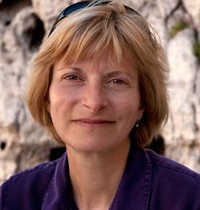NOTE: Images in this archived article have been removed.

The white “bathtub ring” around Lake Mead, the largest reservoir on the Colorado River, demarcates the lake’s previous higher levels. Photo: Sandra Postel
The four largest cities that get their drinking water from the Colorado River are gearing up to pilot an innovative conservation scheme that pays farmers, industries and municipalities to reduce their use of the river’s water.
The main aim of the new initiative is to keep the levels of Lake Mead and Lake Powell, the giant reservoirs behind Hoover Dam and Glen Canyon Dam, high enough to delay or avoid the declaration of a water shortage, which would trigger potentially costly reductions in water deliveries.
Called the Colorado River System Conservation Program,
the fund would be seeded to the tune of $11 million — $3 million from the federal Bureau of Reclamation and $2 million each from the Southern Nevada Water Authority (SNWA, which includes Las Vegas), the Central Arizona Water Conservation District (which includes Phoenix), the Metropolitan Water District of Southern California (which includes Los Angeles), and Denver Water.
Of the four, Las Vegas is most at risk from Colorado River shortages, and therefore has the most to gain from the program’s success.
The city gets about 90 percent of its water from Lake Mead. By mid-April, the lake’s level was only 48 feet above the city’s uppermost intake pipe. And with researchers at the University of California-San Diego’s Scripps Institution of Oceanography projecting that there is a 50 percent chance that by 2036 Lake Mead could drop to “dead pool,” Las Vegas is pursuing multiple options to secure its water future.
At a special session on April 17, the SNWA’s board approved the $2 million contribution to the new conservation fund.
Phoenix, which gets about 47% of its water from the Colorado River, would likely also benefit from the new fund. If drought conditions persist in the Colorado River Basin, there is a significant probability that by 2016 the level of Lake Mead will drop to 1,075 feet above sea level, prompting federal officials to declare a shortage.
According to
new rules put into effect in 2007, the Central Arizona Project (CAP), which delivers Colorado River water to Phoenix and Tucson, could see reductions of up to 320,000 acre-feet, or 11.4% of the CAP’s annual Colorado River allocation. If Lake Mead drops below 1,025 feet, the CAP could see cutbacks of up to 480,000 acre-feet. Although the CAP is banking some of its annual supply for a “dry day,” shortage declarations that extended over many years or decades could cause hardship to central Arizona cities, businesses and farms.
In an April 22
memo, Kathryn Sorenson, the director of water services for Phoenix, recommended that the city explore the benefits of participating in the conservation fund, noting that a “successful program of this nature carried into the future would significantly improve the long-term reliability of Colorado River water supplies.”
Of course, $11 million is a drop in the bucket of what is needed to achieve meaningful conservation savings in the Colorado River Basin. And each of the four cities has substantially more conservation they can do within their own borders. But what is unique about this program is its “we’re in this together” approach.
The fund would pay for voluntary reductions in water use – whether by fallowing farm fields, installing more efficient irrigation systems, recycling industrial supplies, or other means– but the savings would benefit the basin as a whole by increasing reservoir storage and thereby mitigating shortages.
Like
Minute 319, the binational accord signed by the United States and Mexico in late 2012, this proposed conservation program is an innovative and cooperative approach to managing the Colorado River. And as Minute 319 has already shown with this spring’s
“pulse flow” through the Colorado Delta, such an approach has the potential to unleash creative win-win solutions not possible with the zero-sum tactics of the past.
The idea is to pilot the conservation fund for two years, and if it’s working, to expand the funding pie and invest in more water-saving projects.
By collaboratively creating an incentive for basin-wide conservation, the big four urban water users and the Bureau of Reclamation have an opportunity to bring more resilience and adaptability to the drought-stricken, overtapped Colorado River.







